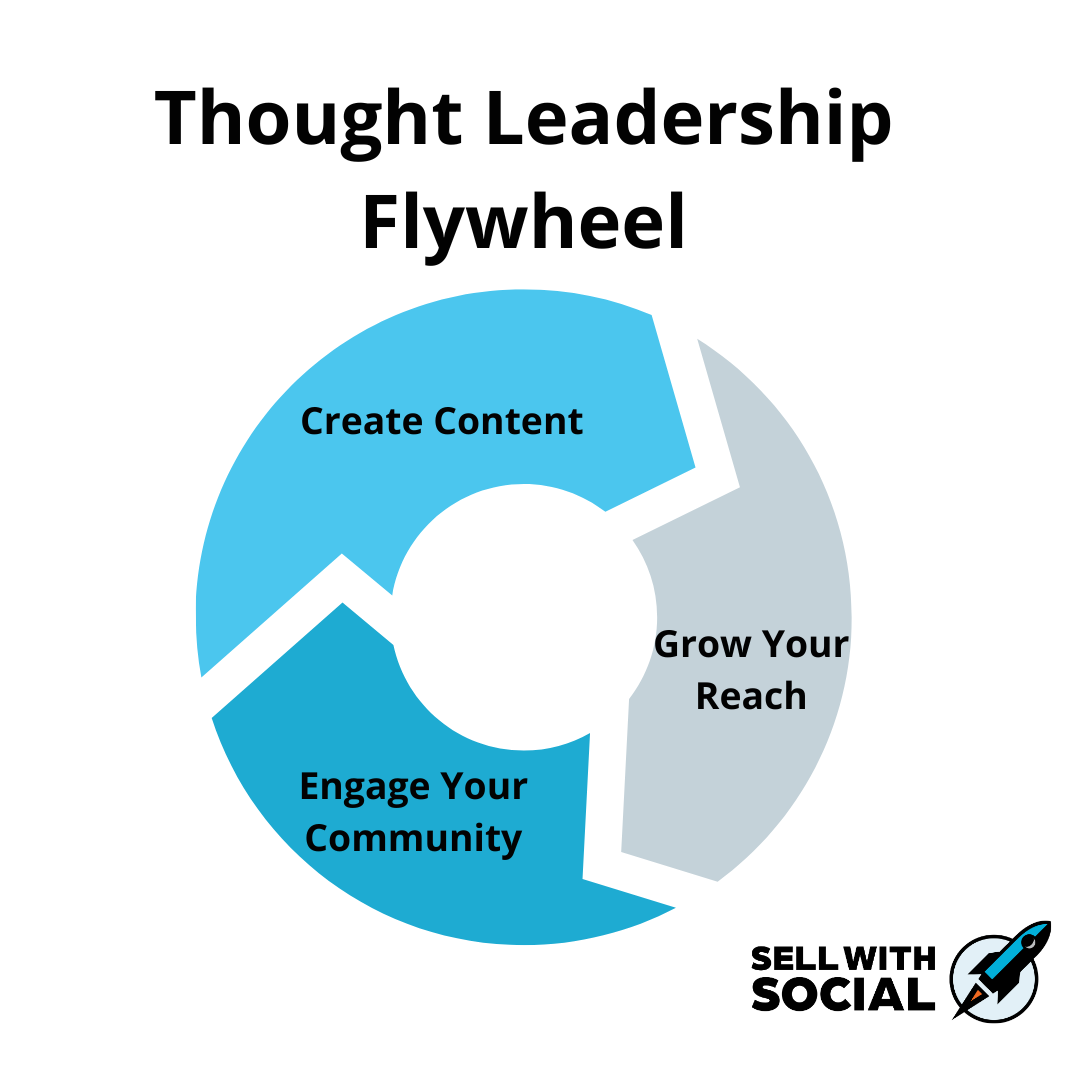The Thought Leadership Flywheel: A Strategy for Growing Your Influence

In the landscape of digital content, establishing yourself as a thought leader in your industry can seem like a daunting task.
Yet, with the right approach, it's more than achievable.
Enter the Thought Leadership Flywheel – a cyclical strategy that propels you towards becoming a beacon of knowledge and trust within your community.
This strategy isn't just about broadcasting your expertise; it's about creating a self-sustaining cycle of content creation, audience growth, and community engagement. And in this week’s Sell with Social, we’ll break down how this works.
Understanding a Flywheel
Before diving into the intricacies of becoming a thought leader, let's first explore the concept of a flywheel and why it's so powerful.
Originating from mechanical engineering, a flywheel is a rotating disk used in machines for its ability to store rotational energy efficiently. When applied to business and content strategy, the flywheel metaphor describes a process that, once set in motion, continues to spin and gain momentum with minimal additional input.
The beauty of the Thought Leadership Flywheel lies in its simplicity and effectiveness. Unlike traditional linear strategies that often require constant energy to push forward, a flywheel leverages its own momentum to keep moving.
This means that every piece of content you create, every interaction with your audience, and every insight you gather not only contributes to your immediate goals but also propels you toward greater growth and influence over time.
Benefits of a flywheel:
- Efficiency: Once momentum is built, it takes less effort to keep it spinning, making your content strategy more sustainable.
- Engagement: A flywheel approach fosters continuous engagement with your audience, deepening relationships and building trust.
- Adaptability: With each cycle, you gain insights that allow you to quickly adapt and refine your strategy, ensuring your content remains relevant and impactful.
In essence, the Thought Leadership Flywheel isn't just about achieving short-term goals; it's about creating a self-sustaining cycle of growth, influence, and community engagement that builds upon itself over time.
The Thought Leadership Flywheel
So without further ado, let’s jump into what the Thought Leadership Flywheel is and how you can create one of your own!
The basic premise is simple. It starts with you creating educational content. This will then help you distribute and grow your reach online. From there, you’ll build an online community to engage with. Which, will in turn, give you insights to create additional educational content.
Create Content > Grow Your Reach > Engage Your Community.

With each additional cycle through the flywheel, you’re growing your thought leadership brand and increasing your effectiveness at reaching and engaging your audience.
Let’s now break down each stage in a little more detail.
1. Create Content: Become the Favorite Teacher
The journey begins with content creation. The goal here is not just to share knowledge but to educate your audience in a way that resonates with them deeply. Imagine yourself as their favorite teacher, someone who can simplify complex concepts and make learning enjoyable. This stage is where you lay down the foundation of your thought leadership.
Actionable Tips:
- Identify Your Audience: Start by understanding the challenges and questions your audience faces. Use these as topics for your content.
- Create Your Content: Whether it's blog posts, videos, podcasts, or infographics, use different formats to cater to various learning styles.
- Focus on Value: Every piece of content should offer clear, actionable insights that help your audience understand your industry better.
2. Grow Your Reach: Expand Your Classroom
As your educational content starts to resonate with your audience, your next focus is on growth. This stage is about expanding the walls of your classroom to include more students eager to learn. The more people you reach, the more you establish your credibility and trustworthiness as a thought leader.
Actionable Tips:
- Leverage Social Media: Share your content across social platforms to increase visibility. Be sure to show up consistently and authentically each day.
- SEO Optimization: Make sure your content is optimized for search engines and social media algorithms to attract organic traffic.
- Collaborate with Peers: Partner with other thought leaders or organizations to tap into their audiences and bring fresh perspectives to your content.
3. Engage Your Community: Foster Conversations and Connections
As your audience grows, so will the engagement from the community you're building. This stage is crucial because it's where the magic of the Thought Leadership Flywheel really starts to show. Engagement in the form of comments, questions, and discussions provides invaluable insights into what your audience is curious about, what challenges they're facing, and how you can help.
Actionable Tips:
- Encourage Interaction: Ask questions at the end of your content to spark discussions. Create polls or surveys to gather opinions and insights.
- Be Responsive: Make it a point to reply to comments and messages. Show your audience that you value their input and are there to engage.
- Host Live Sessions: Webinars, live Q&As, and workshops are excellent ways to interact directly with your audience and deepen those connections.
Back to Step 1: The Flywheel in Motion
With the insights and engagement from your community, you're now equipped to create more targeted, valuable educational content. This feedback loop is the essence of the Thought Leadership Flywheel. Each cycle through these stages not only amplifies your reach and influence but also strengthens the bond with your community, making your content more relevant and impactful.
The Power of the Flywheel
Unlike a linear strategy, the Thought Leadership Flywheel is a dynamic, ongoing process. It's about continuous improvement, adaptation, and growth. As you iterate through these stages, you'll find your voice becoming more authoritative, your content more refined, and your audience more engaged.
Remember, the key to the flywheel's success is momentum. The more effort and quality you put into each stage, the more you'll get out of it. So, start spinning your Thought Leadership Flywheel today, and watch as your influence grows, your community thrives, and your industry presence becomes undeniable.

For this week’s action items, I want you to think about your social strategy and if you are benefitting from a flywheel effect.
Do you have a closed loop in your strategy? Or do you feel like your strategy is fighting against you?
The difference between the two can be massive. A flywheel effect is how you will experience exponential growth with only marginally more input. Whereas a non-flywheel strategy is going to leave you feeling exhausted and defeated.
Here are some actions you can take this week:
- Review Your Strategy - Look at your content and social strategy and determine if you are benefiting from a cyclical self-sustaining approach. You’ll know this is true if you are able to connect the dots between the content you create, the audience you reach, and the engagement that fuels your content ideas.
- Create the Flywheel - Then, if you haven't already done so, build a flywheel effect into your strategy. Use the Thought Leadership Flywheel diagram above as a blueprint for how you can implement this for yourself.
